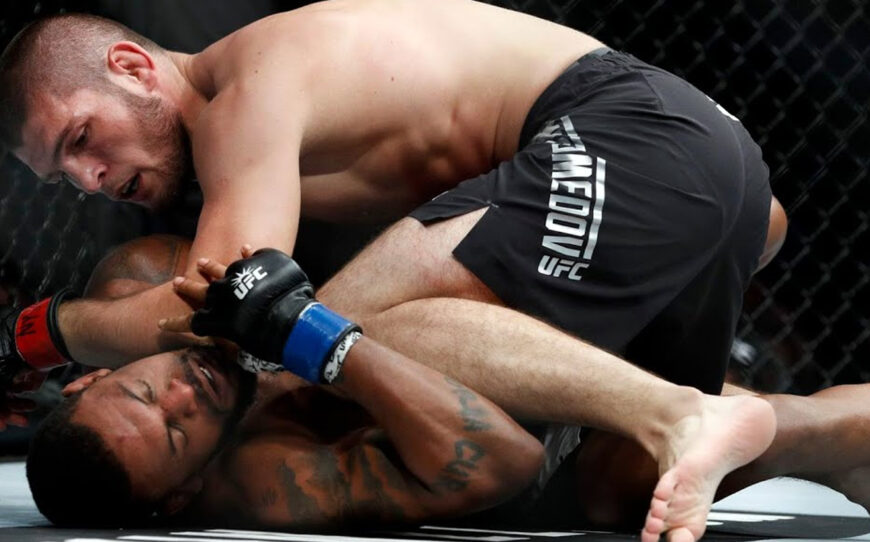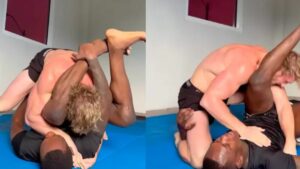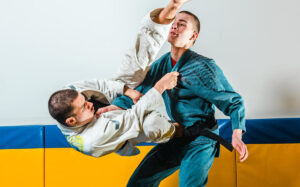Welcome to the fascinating world of grappling techniques, where today we delve into the power and mystique of the Dagestani Handcuff. With its roots in wrestling and Brazilian Jiu-Jitsu, this highly effective technique has gained significant popularity thanks to UFC legend Khabib Nurmagomedov’s dominance inside the cage.
In this blog post, you will learn about the history and mechanics behind this innovative maneuver, along with tips for perfecting your own execution.
Key Takeaways
- The Dagestani Handcuff is a highly effective grappling technique that originated in Dagestan, Russia and has been used in amateur wrestling and MMA for many years.
- By trapping one arm behind their back, practitioners limit their opponent’s defenses leading to a swift victory via submission or technical knockout due to strikes from dominant positions.
- To execute the Dagestani Handcuff properly, you must first gain control of your opponent’s wrist and use your forearm to create pressure on their elbow joint while pulling their arm towards you.
- While the Dagestani Handcuff provides excellent control over an opponent in grappling situations, relying solely on this technique without mastering other grappling moves can be limiting and potentially risky.
The Dagestani Handcuff: Origin And History
The Dagestani Handcuff technique originated in Dagestan, Russia and has been used in amateur wrestling and MMA for many years.
The Background Of The Technique
The Dagestani Handcuff, a highly effective grappling technique, originates from the wrestling-rich region of Dagestan in Russia. This area is renowned for producing some of the world’s best combat athletes who excel in various martial arts disciplines such as sambo, judo, and freestyle wrestling.
One notable practitioner who has popularized this technique on the global stage is Khabib Nurmagomedov, an undefeated UFC champion with an impressive record of 29 wins and no losses.
Khabib’s domination inside the octagon can be largely attributed to his expertise in ground control using this unique trapping maneuver. His success has not only brought attention to this powerful tactic but also showcased how seamlessly it can be integrated into other martial arts disciplines like Brazilian Jiu-Jitsu or mixed martial arts (MMA).
What makes the Dagestani Handcuff stand out from other techniques is its ability to immobilize opponents while maintaining superior control throughout transitions between positions on the ground.
By trapping one arm behind their back, practitioners limit their opponent’s defenses – which often results in a swift victory via submission or technical knockout (TKO) due to strikes from dominant positions.
Its Use In Amateur Wrestling And MMA
The Dagestani Handcuff has become increasingly popular in both amateur wrestling and mixed martial arts (MMA), especially due to its effectiveness in controlling opponents on the ground.
In wrestling, athletes often use the technique to maintain dominant positions and prevent their adversaries from escaping or countering their moves.
In MMA, fighters have adopted the Dagestani Handcuff for various tactical purposes. Notably, it allows them greater control over their opponent’s body while limiting their ability to retaliate effectively.
This advantage can lead to an increased opportunity for submission holds or ground-and-pound attacks by trapping one of the opponent’s arms behind their back.
Khabib Nurmagomedov’s Success With The Technique
Khabib Nurmagomedov, the undefeated former UFC lightweight champion, has become synonymous with the Dagestani Handcuff technique. Throughout his illustrious career in mixed martial arts, Khabib employed this grappling move to devastating effect on many formidable opponents.
One notable example of Khabib’s mastery of the Dagestani Handcuff occurred during his fight against Conor McGregor at UFC 229. By handcuffing McGregor’s wrist behind his back and applying relentless ground pressure, he left “The Notorious” on defense for most of their bout – ultimately leading to a fourth-round submission victory via neck crank.
Understanding The Dagestani Handcuff
To fully understand the Dagestani Handcuff technique, it’s important to grasp how it works and follow a step-by-step guide for executing it, including its variations.
How The Dagestani Handcuff Works
The Dagestani Handcuff is a technique that involves trapping your opponent’s arm behind their back, leaving them vulnerable to strikes or submission holds. The move is executed by taking control of the near side arm and manipulating it so that it is pinned against the opponent’s body.
To execute the Dagestani Handcuff properly, you must first gain control of your opponent’s wrist. Once you have secured the wrist, use your forearm to create pressure on their elbow joint while pulling their arm towards you.
Variations of this technique can be used in different positions such as half guard or turtle position. However, mastering this move requires practice and proper execution as well as being aware of counter techniques from opponents trying to defend themselves.
Step-by-Step Guide To Executing The Technique
To execute the Dagestani Handcuff, follow these steps:
- Establish control: Start in side control or half guard position and control your opponent’s near side arm with your shoulder pressure.
- Trap the wrist: Grab your opponent’s wrist with both hands and twist their arm towards their back, similar to a hammerlock.
- Pull and trap: Pull their arm towards their back while using your body weight to trap them down. Use your free hand to grab their face or neck to maintain control.
- Pin the leg: Use one of your legs to pin down their closest leg for extra control.
- Apply pressure: Keep pulling their arm towards their back while applying pressure on the shoulder joint. This will cause them pain and discomfort, making it difficult for them to escape.
- Finish the move: Once you have trapped their arm behind their back, you can either go for a submission hold or transition into another grappling technique.
Remember that mastering this technique takes practice, so start slow and gradually increase speed as you become more comfortable with it. It’s also important to be aware of counter techniques that opponents may use against you when attempting the Dagestani Handcuff.
Watch the full technique:
Dagestani Handcuff Variations
There are several creative variations of the Dagestani Handcuff, including the Dagestani Handcuff Armlock and Dagestani Handcuff Guard Pass.
Dagestani Handcuff Guard Pass
The Dagestani Handcuff Guard Pass is a powerful technique used in MMA and grappling to control and submit opponents. It involves trapping the opponent’s near-side arm behind their back with your own arm while simultaneously passing their guard.
To execute the Dagestani Handcuff Guard Pass, you need to start from inside your opponent’s half guard position. You then grab their near side wrist, use shoulder pressure to keep them down, and pass their legs as you trap their arm behind their back.
Khabib Nurmagomedov has had great success using this technique in his UFC career, further popularizing its use among fighters worldwide.
Dagestani Handcuff To Ground N Pound (from Guard)
The Dagestani Handcuff to Ground n Pound (from guard) is a powerful technique used by MMA fighters to control their opponents on the ground. This move involves holding your opponent’s near side arm and trapping it behind their back, while simultaneously controlling their legs to prevent them from escaping.
Khabib Nurmagomedov is one fighter who has demonstrated the effectiveness of this technique in his fights. The Dagestani Handcuff to Ground n Pound (from guard) allows fighters to dominate their opponents in a bad position and take control of the fight.
Dagestani Handcuff To Ground N Pound (turtle Position)
The Dagestani Handcuff is not only used for control, but it can also set up a ground and pound attack from the turtle position. Once you have secured your opponent’s near side arm behind their back using the Dagestani Handcuff, you can then step through with your far leg over their body to transition into top position.
From here, you’ll be in perfect position to rain down punches or elbows on your opponent’s exposed face or body. However, it’s important to note that this technique relies heavily on proper execution as one mistake could leave you vulnerable and in a bad position.
The Dagestani Handcuff allows fighters like Khabib Nurmagomedov to dominate opponents both on the ground and standing up, providing them with an edge against even skilled grapplers.
But while mastering this technique is crucial for any fighter looking to improve their grappling skills, relying solely on one move could leave them predictable and vulnerable against more experienced opponents.
Dagestani Handcuff Armlock
The Dagestani Handcuff Armlock is a variation of the Dagestani Handcuff used to control and submit opponents in grappling and ground fighting. The technique involves trapping one of the opponent’s arms behind their back while maintaining shoulder pressure on their other arm.
Then, with a swift motion, you can twist their trapped arm for an armlock submission or use it to transition into other moves like guard passing or ground n pound. This move requires great precision and timing, but when executed correctly, it can be highly effective at breaking down an opponent’s defense and securing a win.
Hammerlock From Cross Body Ride
The Hammerlock from Cross Body Ride is a variation of the Dagestani Handcuff technique that can be used to control and submit an opponent. This move involves transitioning from side control into a cross body ride, where the top player traps their opponent’s near-side arm with their leg and uses their far-side hand to grab the opponent’s wrist.
This variation of the Dagestani Handcuff can be particularly effective against opponents who are trying to defend themselves by turtling up or protecting their neck. It allows for greater control over both arms, making it difficult for them to escape or counterattack.
However, as with any grappling technique, it requires proper execution and timing in order to be successful.
Mastering The Dagestani Handcuff
To improve and perfect the Dagestani Handcuff technique, it’s essential to focus on developing strong grip strength, proper shoulder pressure, and positioning yourself correctly while maintaining control over your opponent’s arm.
Tips For Improving And Perfecting The Technique
To improve and perfect the Dagestani Handcuff technique, follow these tips:
- Master the basic technique: Start by mastering the basic Dagestani Handcuff technique before attempting any variations.
- Focus on shoulder pressure: Apply maximum shoulder pressure when executing the move to control your opponent.
- Practice different grip variations: Experiment with different grip variations on your opponent’s wrist and forearm to find what works best for you.
- Use your body weight: Use your body weight to apply more pressure and control while executing the move.
- Be patient: The Dagestani Handcuff requires patience and timing to execute properly, so take your time and wait for the right moment.
- Follow through with additional submissions: After executing the Dagestani Handcuff, don’t be afraid to follow through with additional submissions such as armlocks or chokes if available.
- Train consistently: Train consistently to improve your execution of the Dagestani Handcuff, including drilling and sparring sessions.
- Watch videos of successful executions: Study footage of successful executions of the Dagestani Handcuff by Khabib Nurmagomedov and other fighters to learn from their techniques.
By following these tips, you can improve and perfect your execution of the powerful Dagestani Handcuff technique in MMA or grappling competitions.
Counter Techniques To Defend Against The Dagestani Handcuff
If you find yourself in a match against an opponent who is skilled in the Dagestani Handcuff technique, there are some counter techniques that you can use to defend against it. Here are some of them:
- Protect your far side arm: Since the Dagestani Handcuff involves trapping the near side arm behind your back, protecting your far side arm can make it difficult for your opponent to execute the technique.
- Use your knees and legs: When your opponent starts to apply pressure with their shoulder, use your knees and legs to create space and prevent them from gaining control.
- Rotate towards your trapped arm: If your near side arm gets caught in the Dagestani Handcuff, rotating towards that arm can alleviate some of the pressure and help you break free.
- Use a counter grip: Grabbing onto your opponent’s wrist or forearm with your free hand can disrupt their grip and give you leverage to escape.
- Counter with a sweep or submission: If you see an opportunity, you can attempt a sweep or submission while in the Dagestani Handcuff position. This can catch your opponent off guard and turn the tables in your favor.
Remember that these counter techniques require quick thinking and execution, so it’s important to train regularly and be prepared for unexpected situations on the mat.
Benefits And Limitations Of The Dagestani Handcuff
The Dagestani Handcuff offers several advantages in grappling and ground fighting, but relying exclusively on this technique may also have some drawbacks.
Advantages In Grappling And Ground Fighting
The Dagestani Handcuff provides excellent control over an opponent in grappling and ground fighting situations. By trapping the near side arm of the opponent behind their back, it restricts their ability to defend themselves and reduces their options for escaping.
Additionally, the technique allows you to exert significant shoulder pressure on your opponent’s face and head, which can be uncomfortable and disorienting. You can also use your free hand to trap one of their legs or apply other submission holds such as a wristlock or armbar.
Drawbacks And Potential Risks Of Relying On The Technique
While the Dagestani Handcuff has proven to be a powerful and effective technique, it also comes with its own set of drawbacks and potential risks. One potential risk is that opponents may begin to anticipate the move after seeing it used repeatedly, making it more difficult to execute successfully.
Another important factor is the risk of injury when executing the Dagestani Handcuff improperly or against an opponent who knows how to counter or defend against it.
While mastering this grappling technique can undoubtedly enhance any fighter’s style and performance, experts recommend incorporating a variety of techniques into training sessions in order to stay unpredictable and better manage different scenarios that may arise during a fight.
How To Use The Dagestani Handcuff In MMA
To effectively use the Dagestani Handcuff in MMA, one should combine it with other grappling techniques and focus on training to optimize performance.
Combining The Technique With Other Grappling Techniques
The Dagestani Handcuff can be a valuable tool when combined with other grappling techniques. Here are some examples of how it can complement other moves:
- Dagestani Handcuff to Armbar: If the opponent tries to resist the handcuff by pushing backward, you can use their momentum to transition into an armbar.
- Dagestani Handcuff to Triangle Choke: As your opponent tries to escape the handcuff, you can use the opportunity to trap their head and arm and wrap your legs around for a triangle choke.
- Dagestani Handcuff to Kimura Lock: With the opponent’s arm trapped behind their back, it becomes easier to secure a kimura lock and force a submission.
- Dagestani Handcuff to Mount: From side control, if your opponent tries to turn away from you, you can trap their hand and spin into mount position.
- Dagestani Handcuff to Back Control: By securing the handcuff with one hand and trapping an arm or controlling the opposite wrist with the other hand, you can transition seamlessly into taking your opponent’s back for a rear-naked choke.
By using these combinations and adding more grappling techniques in your arsenal, you can better enhance your chances of winning during matches or fights.
Training For Optimal Performance
To truly master the Dagestani Handcuff technique, consistent and proper training is required. It’s important to have a trusted coach or trainer who can help you refine your form and technique for maximum effectiveness.
Combining the Dagestani Handcuff with other grappling techniques can also enhance its effectiveness, as well as understanding when it may be appropriate to use.
It’s also essential not to solely rely on one particular move or technique during a fight.
Tips For Doing The Dagestani Handcuff
To execute the Dagestani Handcuff effectively, it is important to maintain shoulder pressure and control your opponent’s near-side arm; other key points include using half guard and turtle position, trapping your opponent’s leg, and applying pressure on their face.
Key Points For Proper Execution
Proper execution of the Dagestani Handcuff requires precision and technique. Here are some key points to keep in mind:
- Set up your opponent: Before attempting to execute the Dagestani Handcuff, it’s important to soften up your opponent with strikes or other grappling techniques.
- Control opponent’s arm: To properly execute the Dagestani Handcuff, you need to control your opponent’s near side arm while maintaining shoulder pressure on their chest.
- Grab wrist firmly: Firmly grab your opponent’s wrist with one of your hands and avoid grabbing too high or too low on their arm.
- Pull and rotate: With your other hand, pull their arm behind their back while rotating their body towards the trapped arm.
- Secure grip: Once you have rotated them enough, secure a grip on your opponent’s wrist using both hands for added control.
- Apply pressure: Use your shoulder to apply pressure on their upper back and trap their arm in place.
- Maintain position: Keep a tight grip on your opponent’s wrist and maintain shoulder pressure to prevent them from escaping.
- Look for openings: While maintaining control, look for opportunities to transition into different positions or finish off your opponent.
By following these key points, martial artists can effectively execute the Dagestani Handcuff technique and gain an advantage over their opponents in grappling and ground fighting situations.
Common Mistakes To Avoid
Here are some common mistakes to avoid when executing the Dagestani Handcuff:
- Failing to control the opponent’s near side arm properly.
- Not maintaining enough shoulder pressure on the opponent’s back.
- Neglecting to control the opponent’s legs or hips while executing the move.
- Pulling too hard on the opponent’s wrist, which could cause injury.
- Forgetting to keep your weight centered and balanced during the technique.
- Relying solely on the Dagestani Handcuff and not having a plan B in case it fails.
- Trying to force the technique when it is not there, which could lead to exposing oneself to counter moves.
By avoiding these common mistakes, fighters can enhance their performance and protect themselves from potential pitfalls during grappling matches. It is important to note that while the Dagestani Handcuff is a powerful technique, it should not be relied upon as the only method for controlling an opponent in ground fighting situations. Instead, incorporating a variety of grappling techniques into one’s training can help fighters better manage different scenarios and improve their overall skill set on the mat or in the ring.
The Importance Of Learning Multiple Grappling Techniques
It is vital for fighters to learn multiple grappling techniques since relying solely on one technique like the Dagestani Handcuff can make them predictable and ineffective against certain opponents who have studied and developed counter techniques.
The Role Of The Dagestani Handcuff In Modern Martial Arts
The Dagestani Handcuff has quickly become one of the most popular moves in modern martial arts. Its simplicity and effectiveness have made it a go-to move for many fighters, both amateur and professional.
This technique is particularly useful for controlling opponents who are turtled up or refusing to engage on their back. It allows fighters to trap one arm behind an opponent’s back while using shoulder pressure to pin their head or control their legs.
In addition to being effective on its own, the Dagestani Handcuff works well when combined with other grappling techniques like guard passes and sweeps.
Incorporating A Variety Of Grappling Techniques
It’s important for fighters to have a varied skillset when it comes to grappling techniques. While the Dagestani Handcuff is an effective move, it shouldn’t be relied on as the only technique in one’s arsenal.
Other moves like sweeps, passes, and submissions should also be practiced and incorporated into a fighter’s game plan.
Additionally, mastering multiple techniques can help fighters become unpredictable in the ring or octagon. Opponents won’t know what type of attack to prepare for next if they’re unsure of what technique a fighter will use.
This was evident in Khabib Nurmagomedov’s fight with Conor McGregor where he used not just the Dagestani Handcuff but also other wrestling moves to secure his victory.
FAQs
1. What is a Dagestani handcuff and how does it work?
A Dagestani handcuff is a type of restraint commonly used in martial arts and self-defense training. It consists of two loops made from sturdy cord or rope that are looped around the attacker’s wrists or forearms, then twisted together to secure them in place.
2. Is it legal to use a Dagestani handcuff for self-defense purposes?
The legality of using a Dagestani handcuff for self-defense purposes may vary depending on your location and local laws. However, in general, any form of physical force should only be used as a last resort after all other options have been exhausted.
3. Can anyone learn how to use a Dagestani handcuff effectively?
Yes, with proper training anyone can learn how to use a Dagestani handcuff effectively for self-defense purposes. It is important to get professional instruction from an experienced teacher who can guide you through the proper techniques and safety precautions.
4. Are there any risks associated with using a Dagestani handcuff during self-defense situations?
Like any form of physical intervention, there are risks associated with using a Dagestani handcuff during self-defense situations if not done properly. These include injury to yourself or your attacker, escalation of violence, or legal implications if used improperly or without just cause. Therefore, it’s essential to receive appropriate training before attempting to use this technique in real-life situations.
Conclusion and Final Thoughts
The Dagestani Handcuff is a powerful grappling technique that has taken the martial arts world by storm. Its use in amateur wrestling and MMA, coupled with Khabib Nurmagomedov’s success in the UFC, has made it an essential move to learn for any serious grappler.
By understanding how the move works and perfecting its execution through proper training, fighters can improve their ground game significantly. However, as with any technique, relying solely on the Dagestani Handcuff without mastering other grappling moves can be limiting and potentially risky.
Therefore, incorporating a variety of techniques into one’s arsenal is critical to ensuring success in modern martial arts.









